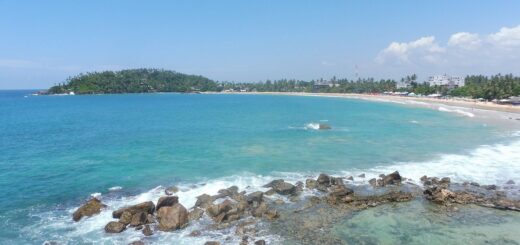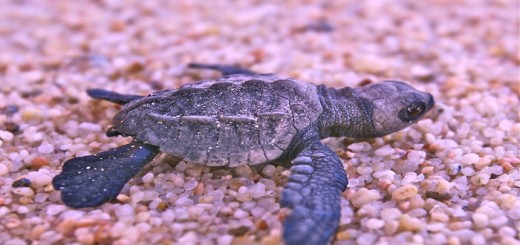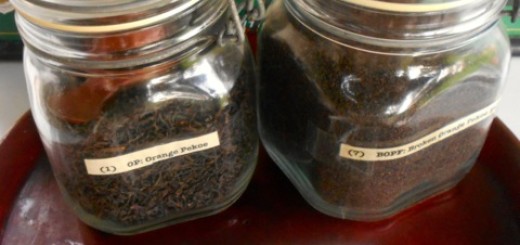SRI LANKA ROUNDABOUT (Number 19) – A Queen’s Travels
by · Published · Updated
A weekly look at Sri Lanka for Jetwing by Royston Ellis
Welcome to Jetwingers around the world to this week’s issue of my regular Jetwing newsletter about Sri Lanka.
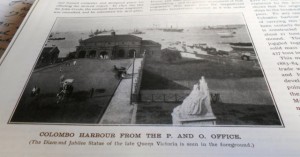 With Queen Elizabeth II of Great Britain recently replacing Queen Victoria as Britain’s longest reigning monarch, it is timely to look at Queen Victoria’s connection with Sri Lanka. Although the Queen never actually visited Ceylon (as Sri Lanka was then known), the country was part of the British Empire and her presence was felt throughout the island. The Queen actually travelled in Colombo, or – to be more exact – her statue did.
With Queen Elizabeth II of Great Britain recently replacing Queen Victoria as Britain’s longest reigning monarch, it is timely to look at Queen Victoria’s connection with Sri Lanka. Although the Queen never actually visited Ceylon (as Sri Lanka was then known), the country was part of the British Empire and her presence was felt throughout the island. The Queen actually travelled in Colombo, or – to be more exact – her statue did.
The story of Queen Victoria’s impressive statue began with the celebration of her diamond jubilee as Queen in 1897, which was commemorated in all the colonies of the Empire. The Ceylon Legislative Council was caught up in the fervour and passed a resolution that a statue of Her Majesty be erected in the island.
Even in those days, politicians were given to hype and one member said enthusiastically: “If anything were to compensate a people for the loss of their national independence, it is to be governed by such a sovereign as Queen Victoria.” Referring to the proposed statue, he stated: “Every one of us now and in the future may look upon her face and say that this has been the greatest and best queen that we have ever known.”
The statue was commissioned from a British sculptor renowned for his statues of royalty and politicians, George Edward Wade (1853-1933). It was his only statue of Queen Victoria and it was masterpiece, made from a single block of Carrara marble from Italy. Governor Ridgeway declared it would be “an effigy (of) which the Colony will have reason to be proud.”
The statue travelled from England by boat in 1902, after the Queen’s death. It was mounted on a square pedestal of grey granite with an octagonal base in front of the passenger jetty of Colombo Harbour opposite the Grand Oriental Hotel. The total height was 21 feet and the weight was 13 tons. The statue showed Queen Victoria in coronation robes and was a formidable sight for ships’ passengers as they disembarked in Colombo, reminding them that Ceylon was British.
Relocated
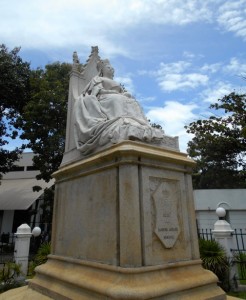 After 13 years towering over arriving passengers, the statue was moved to Gordon Gardens, then adjoining the residence of the Governor General but now part of the President’s House compound. The Queen’s marble profile could be glimpsed from the tops of passing buses. Otherwise unnoticed, she stayed there for 91 years until she was moved in 2006 to a remote site in the grounds of the National Museum.
After 13 years towering over arriving passengers, the statue was moved to Gordon Gardens, then adjoining the residence of the Governor General but now part of the President’s House compound. The Queen’s marble profile could be glimpsed from the tops of passing buses. Otherwise unnoticed, she stayed there for 91 years until she was moved in 2006 to a remote site in the grounds of the National Museum.
It is said that presence of the Queen’s statue in the garden of The President’s House was inimical to the 21st century Sri Lanka. For a while, the fate of the statue was in doubt but it was rescued from ignominy, and given a good scrub, in 2013 in time for the Commonwealth Heads of Government summit in Colombo.
The statue was moved to its present prominent location at the museum’s gates overlooking Ananda Coomaraswamy Mawatha (formerly Green Path) and staring at the park that was named Victoria after the Queen (now called Vihara Mahadevi Park). After 113 years Queen Victoria’s status still looks majestic, an imposing link with the past.
Royston Ellis (www.roystonellis.com) is a British author resident in Sri Lanka since 1980

